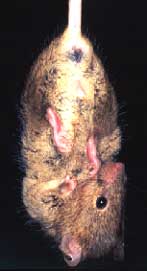| Strain description |
 GM1-gangliosidosis is one of the typical lysosomal storage diseases and neurological genetic diseases caused by lysosomal β-galactosidase (β-Gal) gene mutations. GM1-gangliosidosis is lethal and no effective therapy is available, so the disease is designated intractable diseases. We developed a β-galactosidase knockout mouse (BKO), and demonstrated that the mouse is a useful GM1-gangliosidosis model by showing that the mouse dies by 10 months old with neurologic symptoms caused by GM1 accumulation in neurons (1, 2). We also developed mouse models for infantile and adult forms of GM1-gangliosidosis by genarating transgenic mice with human mutant β-Gal genes. These mouse models are different in age of onset and severity. Furthermore, we are studying therapeutic drugs based on a new mechanism, "chemical chaperones", for treating brains using mouse models (Tg/KO) for human juvenile forms of GM1-gangliosidosis (3). |
| Reference(s) |
- Matsuda J, Suzuki O, Oshima A, Ogura A, Noguchi Y, Yamamoto Y, Asano T, Takimoto K, Sukegawa K, Suzuki Y, and Naiki M. (1997) β-galactosidase-deficient mouse as an animal model for GM1-gangliosidosis. Glycoconj. J. 14(6):729-36. [PMID:9337086]
- Itoh M, Matsuda J, Suzuki O, Ogura A, Oshima A, Tai T, Suzuki Y, and Takashima S. (2001) Development of lysosomal storage in mice with targeted disruption of the β-galactosidase gene: a model of human GM1-gangliosidosis. Brain Dev. 23(6):379-84. [PMID:11578847]
- Matsuda J, Suzuki O, Oshima A, Yamamoto Y, Noguchi A, Takimoto K, Itoh M, Matsuzaki Y, Yasuda Y, Ogawa S, Sakata Y, Nanba E, Higaki K, Ogawa Y, Tominaga L, Ohno K, Iwasaki H, Watanabe H, Brady RO, and Suzuki Y. (2003) Chemical chaperone therapy for brain pathology in GM1-gangliosidosis. Proc. Natl. Acad. Sci. U.S.A. 100(26):15912-7. [PMID:14676316]
|

